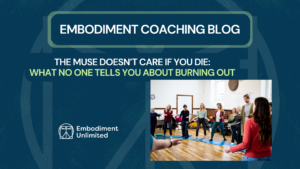Embodiment coaching integrates the wisdom of the body into the coaching process, providing profound tools for personal growth and transformation. This approach encourages clients to reconnect with their physical sensations, emotions, and instincts to navigate challenges, rediscover purpose, and build resilience.
For coaches, understanding and applying embodiment techniques can revolutionise the way you support clients, particularly when addressing themes such as burnout, changing energy levels, and the need for support. Below, we will explore how embodiment practices illuminate these concepts and suggest practical applications to enhance your coaching practice.
Rethinking Purpose and Energy
One of the foundational elements of embodiment coaching is assisting clients in navigating their relationship with purpose. Energy, motivation, and passion naturally ebb and flow over time, leading clients to question commitments that once brought them fulfilment.
Rather than approaching these shifts solely through cognitive exploration, embodiment coaching encourages clients to tune into their body’s signals. Is their fatigue indicating a need for a break, or is it highlighting a deeper need for change? Helping clients cultivate this nuanced awareness fosters clarity and alignment with their evolving priorities.
Vulnerability and the Embodiment of Support
Many individuals find it challenging to accept help, often adopting a “lone warrior” mindset that can lead to burnout. Embodiment coaching can gently guide clients in exploring what it feels like to receive support—both physically and emotionally.
For instance, experiencing resistance through clenched postures versus openness through expansive stances provides a somatic understanding of their inner dynamics. These physical explorations aid clients in building awareness, shifting behaviour patterns, and opening avenues for collaboration and co-regulation.
Embodiment as a Tool for Building Resilience
Resilience is not merely about bouncing back; it involves expanding one’s capacity to navigate life’s challenges. By guiding clients to remain attuned to their body’s signals, coaches can help them explore the edges of their “window of tolerance.”
For example, through gentle movement, breathwork, or guided attention, clients can learn to recognise when they are nearing their limits. They can also practise intentionally pausing or recalibrating before tipping into overwhelm. This embodied approach not only enhances self-regulation but also fosters long-term resilience.
Cultivating Acceptance and Flexibility
In embodiment coaching, acceptance is a key practice. Whether clients are navigating evolving relationships or dealing with unmet expectations, embodiment offers tools for embracing their current reality.
Instead of focusing solely on external outcomes, clients can utilise embodiment techniques to ground themselves in the present. This might involve connecting with sensations of stability in the body, practising deep breaths, or exploring movements that embody adaptability. These practices cultivate a mindset of curiosity and flexibility, enabling clients to meet challenges with greater ease.
Integrating Embodiment into Your Coaching Practice
Incorporating embodiment into your coaching practice doesn’t require extensive retraining; it’s about introducing small but impactful shifts. Here are some strategies:
- Body Awareness Practices: Encourage clients to notice their physical sensations during moments of reflection or decision-making. This can reveal hidden insights into their emotions and needs.
- Movement Exploration: Employ simple movements to explore concepts such as openness, grounding, or balance. This could be as subtle as shifting weight between feet or experimenting with posture.
- Nervous System Literacy: Educate clients about the body’s stress responses and the significance of practices that activate their ventral vagal system—the state associated with safety and connection.
- Co-Regulation Exercises: Encourage clients to explore how relationships (with people, nature, or community) can bolster their well-being.
A Call to Coaches
Embodiment coaching is not merely a technique; it’s an invitation to approach growth holistically, acknowledging the profound intelligence of the body. By incorporating these practices, you empower your clients to transcend surface-level change and enter a realm of deep, sustainable transformation.
Whether you are an experienced coach or new to this field, exploring embodiment techniques can enrich your practice and provide a powerful path to meaningful change. Begin with curiosity, and allow the body to guide the way.
If you wish to delve deeper into embodiment coaching, consider exploring training opportunities or workshops designed to integrate these principles into your work. Transformation begins with one small, intentional step.
Become a certified embodiment coach
Learn the principles, tools and techniques you need to coach safely and effectively with the body. You’ll explore ways to work with your clients to bring about real, lasting change and support them in their growth.
For more information about the Certificate of Embodiment Coaching – visit our CEC page



